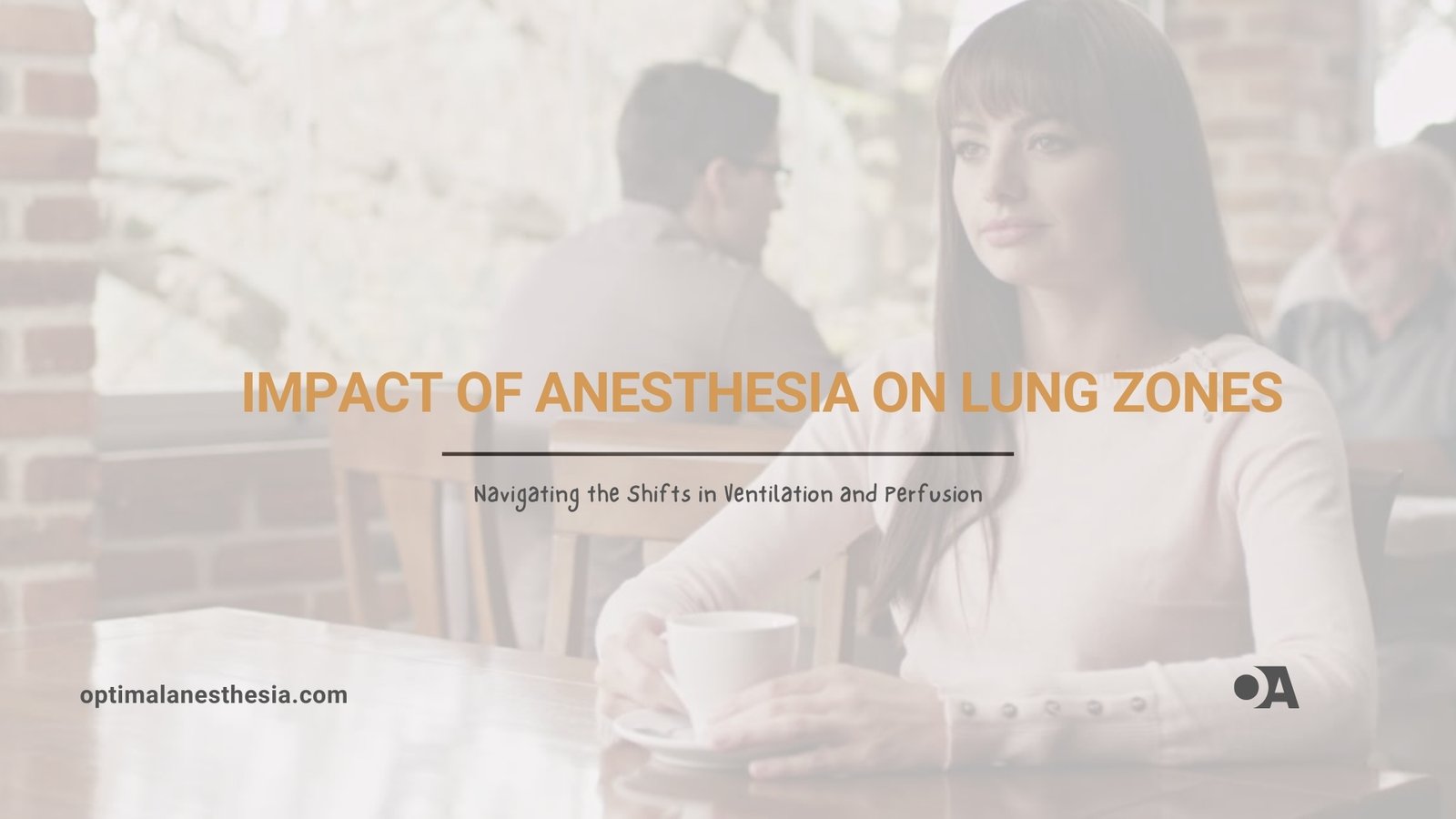Introduction
Understanding lung zones and their behavior under anesthesia is critical for anesthesiologists to ensure optimal ventilation strategies, maintain effective gas exchange, and minimize perioperative respiratory complications. This article delves into the effects of anesthesia on lung zones, their physiological implications, and how these changes impact anesthetic management.
Lung Zones: A Brief Overview
The lungs are classically divided into four zones based on the West’s zones model, which describes the relationship between alveolar pressure (PA), arterial pressure (Pa), and venous pressure (Pv) across different regions of the lungs:
- Zone 1: PA > Pa > Pv – Represents alveolar dead space where ventilation exceeds perfusion.
- Zone 2: Pa > PA > Pv – Blood flow is driven by the difference between arterial and alveolar pressures.
- Zone 3: Pa > Pv > PA – Perfusion is primarily dependent on arterial-venous pressure differences.
- Zone 4: Exists under conditions of low lung volume or edema, where interstitial pressure exceeds alveolar pressure, impacting blood flow.
Effects of Anesthesia on Lung Zones
1. Reduction in Functional Residual Capacity (FRC)
General anesthesia reduces FRC by approximately 15–20% in adults, a change that occurs beyond the effect of supine positioning. This decrease leads to increased atelectasis, especially in dependent lung regions, and promotes the formation of lung zones with mismatched ventilation and perfusion .
- Clinical Implication: Reduced FRC under anesthesia leads to the closure of small airways in dependent lung regions, resulting in hypoventilation, atelectasis, and V/Q mismatch.
Detailed Reference:
- Malbouisson LM, Carmona MJ, Pereira SM, et al. Effects of anesthesia on the respiratory system. Best Pract Res Clin Anaesthesiol. 2015;29(3):363-373. Available at: https://www.sciencedirect.com/science/article/abs/pii/S1521689615000610
2. Atelectasis Formation
More than 80% of patients, particularly children under three years, develop atelectasis immediately following induction of anesthesia . This atelectasis predominantly affects the dependent lung regions, leading to an increase in intrapulmonary shunt and hypoxemia.
- Clinical Implication: Atelectasis reduces gas exchange efficiency, resulting in hypoxemia and increased potential for postoperative pulmonary complications. Recruitment maneuvers and the application of PEEP can counteract this effect.
Detailed Reference:
- von Ungern-Sternberg BS, Boda K, Chambers NA, et al. The impact of anesthesia on pediatric lung function. Br J Anaesth. 2014;113(Suppl 2):ii5-ii10. Available at: https://www.bjanaesthesia.org.uk/article/S0007-0912(17)33830-8/fulltext
3. Altered V/Q Matching
Anesthesia affects ventilation-perfusion matching by promoting a shift of blood flow and altering the distribution of ventilation across lung zones, leading to hypoxemia. The development of Zone 1 increases dead space ventilation, while the expansion of Zone 3 results in shunting .
- Clinical Implication: Understanding how anesthesia affects V/Q matching helps tailor ventilation strategies, such as optimizing PEEP and adjusting tidal volumes to prevent atelectasis and hypoxemia.
Detailed Reference:
- Perilli V, Aceto P, Sacco T, et al. Anesthetic techniques and drugs’ effects on pulmonary function. Clin Ter. 2015;166(2):e50-e56. Available at: https://www.ncbi.nlm.nih.gov/pmc/articles/PMC4613402/
Zone-Specific Anesthesia Implications
Zone 1 (Alveolar Dead Space)
During anesthesia with positive pressure ventilation, alveolar pressure often exceeds pulmonary arterial pressure, expanding Zone 1 and increasing dead space ventilation.
- Management: Appropriate PEEP levels help prevent overdistention of alveoli and reduce dead space.
Zone 2 and Zone 3 Changes
The boundary between Zones 2 and 3 is affected by changes in blood flow and airway pressure during anesthesia.
- Management: Careful titration of tidal volume and PEEP can optimize alveolar recruitment and minimize shunting.
Zone 4 Expansion
Zone 4 may become more pronounced due to decreased lung compliance and increased interstitial pressure during anesthesia.
- Management: Lung-protective ventilation strategies are crucial to prevent fluid accumulation and interstitial edema.
Detailed Reference:
- Hemmings HC, Egan TD. Basic Physiology for Anaesthetists. Cambridge University Press, 2013. Chapter 15: West Zones. Available at: https://www.cambridge.org/core/books/basic-physiology-for-anaesthetists/west-zones/A8B6668B2A85F41F8C5F6B93C393EDB2
Key Factors Affecting Lung Zones During Anesthesia
- Patient Positioning: The supine position shifts blood flow to dependent lung regions, altering zone distribution and increasing the likelihood of atelectasis formation.
- Mechanical Ventilation: Positive pressure ventilation increases alveolar pressure, which can expand Zone 1 and reduce perfusion in other lung zones.
- Neuromuscular Blockade: Muscle relaxation exacerbates the reduction in FRC, leading to airway closure and atelectasis.
Clinical Strategies for Managing Lung Zones Under Anesthesia
- Recruitment Maneuvers: Regular recruitment maneuvers help reopen collapsed alveoli, reducing atelectasis and improving oxygenation .
- Lung Ultrasound Monitoring: Ultrasound can identify atelectatic regions and guide ventilation strategies in real-time.
- Individualized PEEP Titration: Adjusting PEEP based on patient characteristics helps maintain lung volume and optimize V/Q matching.
Detailed Reference:
- Edmark L, Östberg E, Enlund M, et al. Recruitment maneuvers during anesthesia – prevention and treatment of lung collapse. Anesthesiology. 2003;102(4):838-841. Available at: https://pubs.asahq.org/anesthesiology/article/102/4/838/7386/Pulmonary-AtelectasisA-Pathogenic-Perioperative
Conclusion
Anesthesiologists must consider the effects of anesthesia on lung zones to optimize ventilation strategies, prevent hypoxemia, and minimize postoperative complications. Tailoring anesthesia management to maintain optimal lung zone distribution plays a crucial role in improving patient outcomes, especially in procedures requiring positive pressure ventilation or in high-risk populations.


